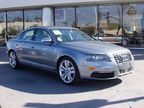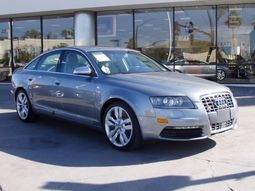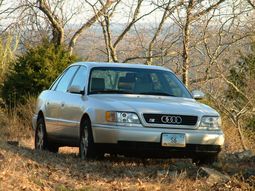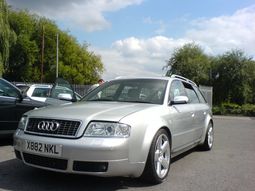The History Of AUDI S6

The Audi S6 is a high-performance version of the Audi A6, an executive car produced by German automaker Audi. It went on sale in 1994, shortly after the "A6" designation was introduced, replacing the "100" nameplate. The original S6 was largely the same car as the outgoing, original Audi S4, with the only visible differences being new body-cladding and badging.
The S6, like all Audi "S" models, is fitted as standard with Audi's trademark quattro four-wheel drive (4WD) system, the S6 using the Torsen-based permanent 4WD.
See also: Audi Ur-S4 / Ur-S6and Audi S4#C4Audi was restructuring their model lineup in early and mid-1990s, and in 1995 began selling the fifth generation (C4) Audi 100 model re-badged as the Audi A6. Wanting to keep a sports-saloon in their lineup, the company made small revisions to what was previously known as the Audi S4, renaming it the Audi S6; the S4 name would eventually be re-used for a completely different model derived from Audi's smaller Volkswagen Group B platform-based Audi A4. As this was the first S6 model from Audi, it is commonly referred to as the Ur-S6, derived from the German augmentive, Ursprünglich (meaning: original).
It was available as both a saloon/ sedan, and an "Avant" (estate/ wagon) to European and United States customers, but only as a saloon in Canada, Asia and Australia.
C4 powertrain
For 1995, the S6 was powered by a 2,228cc (136.0cuin) turbocharged inline five-cylinder petrol engine, producing 169kW (230PS; 227bhp) at 5900rpm and 326N·m (240.4ft·lbf) at around 1950rpm. The powerful engine gave the S6 surprisingly good performance, it had a top speed of 235km/ h (146mph) and went from 0 to 100km/ h (62mph) in 6.1 seconds; 160km/ h (99mph) was reached in 17.5 seconds. After a chip. Car easily achieves ~280HP.
The vehicle came standard with a six-speed manual transmission (5 speed only in North America), and Audi's Torsen T-2 quattro permanent four-wheel drive system.
Audi made a high-performance, 4.2L V8 engine available as an option in the original European S4s, and made the decision to continue to do so with the S6, making a 213kW (290PS; 286bhp) version of the 4.2 available as an optional upgrade over the 2.2L 5-cylinder. Unlike the 5-cylinder turbocharged version, the V8-powered S6 was supplied with an automatic transmission as standard, but kept the quattro four wheel drive. A 6-speed manual gearbox was also available as an option.
C4 brakes, wheels and tyres
C4 braking system included radially ventilated disc brakes front and rear, with 10.9in (276.9mm) diameter discs up front, and 10.6in (269.2mm) diameter discs at the rear. Anti-lock braking system (ABS) was also standard.
Standard wheels were 7½Jx16 "Avus" cast aluminium alloy wheels with 225/ 50R16 tyres. An optional 7½Jx15 alloy wheel, with 215/ 60R15 tyres was also available.
Audi S6 Plus
An even more powerful, and very limited-production S6 Plus, powered by another version of the 32 valve 4.2 litre V8 (engine code AHK, later to be seen in the Audi S8, as AKH), was briefly available to European customers. The S6 Plus, developed by quattro GmbH (a wholly owned subsidiary of Audi AG), was available for sale during the 1997 model year only (production from April 1996 to July 1997). A total of 952 cars were produced - 855 Avant (estate), and 97 saloons. Audi's performance division reworked key parts of the engine, increasing the power output to 240kW (326PS; 322bhp). They also made revisions to the suspension, brakes and transmission. With so much power on tap, the S6 Plus could reach 100km/ h (62mph) from a standstill in 5.6 (saloon) and 5.7 (Avant) seconds, making it comparable in terms of acceleration to vehicles like the Porsche 944 Turbo.
In 1997, Audi introduced an all-new range of Audi A6 models, based on the Volkswagen Group C5 platform. A new Audi S6, now officially known as the Audi S6 quattro appeared in 1999, to compliment its A6 platform-mate. It was available in a 4-door saloon/ sedan and a 5-door Avant (estate/ wagon). In North America the Avant bodystyle was the only version available.
This generation of S6 went out of production in 2003.
C5 powertrain
Aluminium alloy subframes supported the major mechanical components, including the engine. Power is from a 4.2 litre 40-valve 90° V8 petrol engine (code AQJ).
A six-speed manual transmission was standard fitment, and optional five-speed tiptronic automatic transmission (gear ratios: 1st: 3.571, 2nd: 2.200, 3rd: 1.508, 4th: 1.000, 5th: 0.803), with steering wheel-mounted paddle-shifts, and "Dynamic Shift Programme" (DSP) was available. Torsen T-2 based quattro permanent four-wheel drive was also standard. Final drive ratio (with automatic transmission) was 2.727, and both axles utilised "Electronic Differential Lock" (EDL).
In 2000, there was a new all aluminium alloy 4.2L EU3 emissions standard V8 engine, now with 40-valves (5 per cylinder) and two-stage magnesium variable intake manifold (code ANK, ASG, ARS, AWN, BBD?). It displaced 4,172cc (254.6cuin), and produced 250kW (340PS; 340bhp) at 6600rpm, and 420N·m (310ft·lbf) of torque at 3400rpm. Engine management was by way of a Bosch Motronic ME7.0 engine control unit, with sequential fuel injection, mapped direct ignition with eight individual spark coils, cylinder-selective knock control, and a drive by wire throttle. The vehicle could now go from 0 to 100km/ h (62mph) in 5.7 seconds and from 0 to 200km/ h (124mph) in just 21.7 seconds. The top speed was electronically governed to 250km/ h (155mph).
C5 suspension and steering
The suspension was stiffened and lowered by 10mm (0.39in), and utilised gas-pressurised shock absorbers.
Rack and pinion "Servotronic" speed-sensitive power steering was standard.
C5 brakes, wheels and tyres
Brakes consisted of radially vented brake discs front and rear. The fronts are sized at 321mm (12.64in) diameter by 30mm (1.18in) thick, and are clamped by four-pad HP2 calipers. At the rear, the discs are 256mm (10.08in) by 22mm (0.87in).
Bosch ESP5.7 Electronic Stability Programme, with Anti-lock Braking System (ABS), brake assist, and Electronic Brakeforce Distribution (EBD) completed the brake system.
Wheels are 8Jx17" cast alloy "Avus" 6-spoke alloy wheels, with 255/ 40 ZR17 tyres.
C5 body and interior
The body panels were largely based on the Audi A6 4.2 model, with flared wheel arches and door sills, with the bonnet (hood) and front wings being constructed from aluminium. Other features included S6 badging, bolstered seats (optional Recaro seats), polished aluminium exterior door mirror housings, unique front grille, and rear decklid spoiler.
Audi RS6 (C5)
Main article: Audi RS6A higher performance RS6 was also available, built by quattro GmbH, using a twin-turbo version of the 4.2litre V8 (code BCY). Power figures were 450 hp/ 331 kW at 5700 rpm - 6400 rpm, 560N·m (410ft·lbf) from 1950 rpm - 5600 rpm. Transmission was a 5 speed tiptronic automatic, 0-100 km/ h took just 4.8 seconds. 0-200 km/ h was 17.6 (saloon) and 17.8 (avant) seconds. Wheels were upgraded to 255/ 40 R18 or 255/ 35 R19 (5/ 15 arm design), and there was an optional Dynamic Ride Control (DRC) system available, which featured diagonally interlinked shock absorbers, to give better body control during extreme cornering, acceleration and braking. Compared to standard A6, the suspension was lowered by 25mm (1.0in). The brake discs were ventilated and upgraded to 365/ 335mm front/ rear.
The latest Audi S6 quattro model (Typ 4F) was introduced at the 2006 North American International Auto Show in January. It is based on the current C6 Audi A6, and uses the Volkswagen Group C6 platform, and is available in saloon/ sedan and Avant (estate/ wagon) bodystyles.
C6 powertrain
The C6 S6 features an all aluminium alloy 5,204cc (317.6cuin) Fuel Stratified Injection (FSI) 40-valve V10 petrol engine, derived from the Lamborghini Gallardo, re-tuned to produce 320kW (440PS; 430bhp) at 6800rpm and 540N·m (400ft·lbf) of torque between 3000 - 4000rpm. It utilises twin chain-driven double overhead camshafts (DOHC), and variable valve timing for both intake and exhaust valves.
The same engine is used in the Audi S8, where it develops 331kW (450PS; 444bhp).
A six-speed tiptronic automatic transmission (gear ratios - 1st: 4.171, 2nd: 2.340, 3rd: 1.521, 4th: 1.143, 5th: 0.867, 6th: 0.691), with steering wheel-mounted "paddle-shifers" is the only transmission available. Torsen-based quattro permanent four-wheel drive, and from 2007 model year with the latest 40:60 front:rear asymmetric/ dynamic Torsen T-3 differential, are standard. The final drive ratio is 3.801, and traction is assisted "Electronic Differential Lock" (EDL) and "Anti-Slip Regulation" (ASR) (commonly known as traction control system).
For the sprint to 100km/ h (62mph), the S6 takes 5.2 seconds, with the quarter mile passing in 13.5 seconds.
C6 brakes, wheels and tires
The brakes consist of radially ventilated discs front and rear. The fronts are sized at 385mm (15.16in) in diameter, and the rears at 330mm (12.99in). An electro-mechanical parking brake works on the rear.
A Bosch ESP8.0 Electronic Stability Programme, with Anti-lock Braking System (ABS), brake assist, and Electronic Brakeforce Distribution (EBD) completed the brake system.
Standard alloy wheels consist of 9Jx19" cast aluminium alloy "5-arm wing design", shod with 265/ 35ZR19 tyres. An optional 8½Jx18" cast alloy "S design" with 255/ 40ZR18 tyres are also available. A direct-acting tyre pressure monitoring system is also standard.
Other features
The S6 features two rows of 5 distinctive LED daytime running lamps (DRLs) along each side of the front bumper as a point of differentiation from other A6 models. Bi-Xenon HID adaptive headlights which swivel around corners compliment the LED DRLs.
From Wikipedia, the free encyclopedia
More About AUDI S6




|